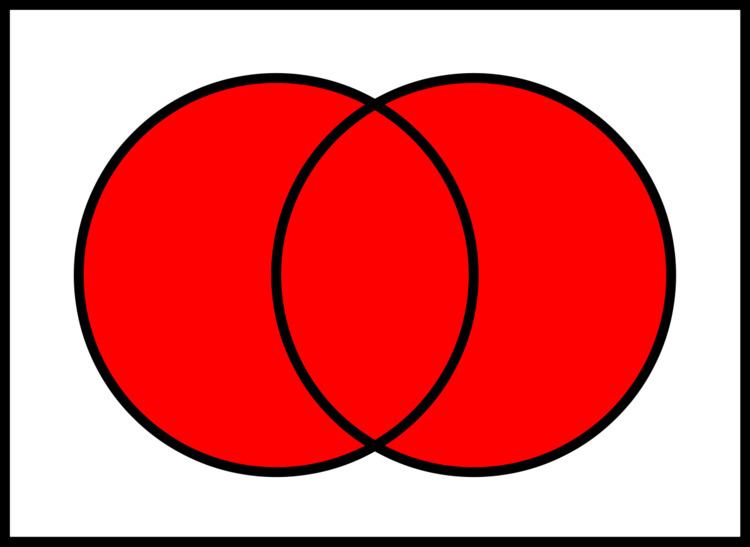 | ||
In set theory, the union (denoted by ∪) of a collection of sets is the set of all elements in the collection. It is one of the fundamental operations through which sets can be combined and related to each other.
Contents
For explanation of the symbols used in this article, refer to the table of mathematical symbols.
Union of two sets
The union of two sets A and B is the set of elements which are in A, in B, or in both A and B. In symbols,
For example, if A = {1, 3, 5, 7} and B = {1, 2, 4, 6} then A ∪ B = {1, 2, 3, 4, 5, 6, 7}. A more elaborate example (involving two infinite sets) is:
A = {x is an even integer larger than 1} B = {x is an odd integer larger than 1}As another example, the number 9 is not contained in the union of the set of prime numbers {2, 3, 5, 7, 11, …} and the set of even numbers {2, 4, 6, 8, 10, …}, because 9 is neither prime nor even.
Sets cannot have duplicate elements, so the union of the sets {1, 2, 3} and {2, 3, 4} is {1, 2, 3, 4}. Multiple occurrences of identical elements have no effect on the cardinality of a set or its contents.
Algebraic properties
Binary union is an associative operation; that is,
A ∪ (B ∪ C) = (A ∪ B) ∪ C.The operations can be performed in any order, and the parentheses may be omitted without ambiguity (i.e., either of the above can be expressed equivalently as A ∪ B ∪ C). Similarly, union is commutative, so the sets can be written in any order.
The empty set is an identity element for the operation of union. That is, A ∪ ∅ = A, for any set A. This follows from analogous facts about logical disjunction.
Since sets with unions and intersections form a Boolean algebra, intersection distributes over union
and union distributes over intersection
Within a given universal set, union can be written in terms of the operations of intersection and complement as
where the superscript C denotes the complement with respect to the universal set.
Finite unions
One can take the union of several sets simultaneously. For example, the union of three sets A, B, and C contains all elements of A, all elements of B, and all elements of C, and nothing else. Thus, x is an element of A ∪ B ∪ C if and only if x is in at least one of A, B, and C.
In mathematics a finite union means any union carried out on a finite number of sets: it doesn't imply that the union set is a finite set.
Arbitrary unions
The most general notion is the union of an arbitrary collection of sets, sometimes called an infinitary union. If M is a set whose elements are themselves sets, then x is an element of the union of M if and only if there is at least one element A of M such that x is an element of A. In symbols:
This idea subsumes the preceding sections, in that (for example) A ∪ B ∪ C is the union of the collection {A, B, C}. Also, if M is the empty collection, then the union of M is the empty set.
Notations
The notation for the general concept can vary considerably. For a finite union of sets
Whenever the symbol "∪" is placed before other symbols instead of between them, it is of a larger size.
